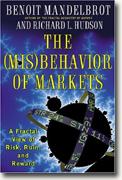Benoit Mandelbrot & Richard L. Hudson
book reviews:
· general fiction
· chick lit/romance
· sci-fi/fantasy
· graphic novels
· nonfiction
· audio books
· author interviews
· children's books @
curledupkids.com
· DVD reviews @
curledupdvd.com
newsletter
win books
buy online
links
home
for authors
& publishers
for reviewers

 |
The (Mis)Behavior of Markets: A Fractal View of Risk, Ruin, and Reward Benoit Mandelbrot & Richard L. Hudson Basic Books Hardcover 328 pages August 2004 |
|
Finance is chaotic and thus difficult to predict. Obvious, right?
Louis Bachelier founded modern financial theory. He assumed prices, and price changes, were independent and based on a normal distribution (the bell curve). In other words, the amount a stock rises or falls today has nothing to do with its rise or fall yesterday, and if you graphed all the rises and falls over a month or a year, there would be lots of small changes and not a lot of large changes. These assumptions are common in all statistics. They simplify the math; sometimes they're necessary to make the math even possible. Does this matter? Mandelbrot simplifies the positivist reaction to innacuracies in the formulae by saying, "If so [if the answers are accurate], then stop arguing about it." But he goes on, "Alas, by that measure..., the standard tools of finance often fail" (p 100). However, financial data shows they aren't true. They don't accurately describe or predict data. Modern financial theory does not predict risk accurately. It does not tell investors how to invest. It is worse than useless. Mandelbrot presents his chaos theory as a possible way to interpret and predict financial data. Currently, he has shown a remarkable ability to simulate financial data - he offers four charts of price data, two real, one created by traditional theory with independence of change and normal distribution of price differences, and one created by his own formula (p 17). The one created by traditional theory is obviously fake, even to the naked eye of the uninitiated. The other three are effectively indistinguishable in terms of realism. Chaos theory is the theory that everything affects everything else. A butterfly flapping its wings in Brazil affects the wind, and New York City sees thunderstorms instead of sunshine. Often cause and effect are so complex as to be effectively untraceable. Chaos measures roughness and turbulence. Geometry, algebra, and their applications in financial theory assume a "smoothness" that doesn't seem to exist in nature. Nature is rough and uneven. Mandelbrot calls for a theory to take this roughness into account as chaos theory has taken roughness into account for geometry. Mountains are not smooth pyramids; they have a rough texture. The increase in price of a stock is not a smooth line; it is jagged and rough. The data is different, but the mathematics are the same. Prices do not move by chance; they react to themselves and to events outside of the market. Mandelbrot calls for a better set of statistics that do not require independent, normally distributed data. He also calls for more research and for a fraction of the federal funding that goes to understand the financial markets to be spent to explore possible applications of chaos theory. This is not a "get rich" book; his only financial advice is to stick with index funds - even the highest-paid financial analysts can't reliably beat the market. He provides a wonderful and brief introduction to chaos theory for those unfamiliar with it. He assumes nothing from his readers but interest and an open mind. He closes his book with a summary of "10 Heresies" of finance (p 225), ten applications of chaos theory that serve to remind the reader what she has just learned: that markets are turbulent, that markets are risky, that prices leap instead of moving steadily. All in all, this is a well-written, well-researched book that anyone interested in math or finance will be able to understand. A fascinating, though slow, read, this book should change the way we look at financial theory in the years to come. © 2004 by Janine Peterson for curledup.com. |
|
|
|
 Click here to learn more about this month's sponsor! |
|
| fiction · sf/f · comic books · nonfiction · audio newsletter · free book contest · buy books online review index · links · · authors & publishers reviewers |
|
| site by ELBO Computing Resources, Inc. | |
 Not according to centuries of financial theory. Benoit
Mandelbrot, the inventor of chaos theory, challenges
traditional financial thinking about prediction, risk, and
even description in a book that's both revolutionary to
the theorist and accessible to the layperson. There's not
a single equation, only a few graphs, and a very limited
number of Greek letters. Mandelbrot and co-writer Richard
Hudson, the editor of the Wall Street Journal Europe,
explain modern financial theory from its history through
its current applications in business school and on Wall
Street and make their case against it. Mandelbrot presents
chaos theory as a possible though underdeveloped
alternative.
Not according to centuries of financial theory. Benoit
Mandelbrot, the inventor of chaos theory, challenges
traditional financial thinking about prediction, risk, and
even description in a book that's both revolutionary to
the theorist and accessible to the layperson. There's not
a single equation, only a few graphs, and a very limited
number of Greek letters. Mandelbrot and co-writer Richard
Hudson, the editor of the Wall Street Journal Europe,
explain modern financial theory from its history through
its current applications in business school and on Wall
Street and make their case against it. Mandelbrot presents
chaos theory as a possible though underdeveloped
alternative.